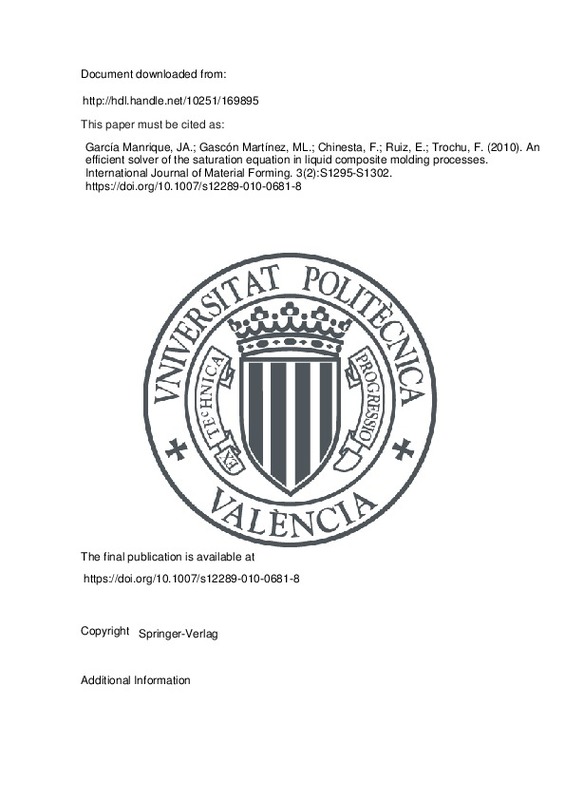JavaScript is disabled for your browser. Some features of this site may not work without it.
Buscar en RiuNet
Listar
Mi cuenta
Estadísticas
Ayuda RiuNet
Admin. UPV
An efficient solver of the saturation equation in liquid composite molding processes
Mostrar el registro sencillo del ítem
Ficheros en el ítem
| dc.contributor.author | García Manrique, Juan Antonio
|
es_ES |
| dc.contributor.author | Gascón Martínez, María Llanos
|
es_ES |
| dc.contributor.author | Chinesta, F.
|
es_ES |
| dc.contributor.author | Ruiz, E.
|
es_ES |
| dc.contributor.author | Trochu, F.
|
es_ES |
| dc.date.accessioned | 2021-07-23T03:31:00Z | |
| dc.date.available | 2021-07-23T03:31:00Z | |
| dc.date.issued | 2010-09 | es_ES |
| dc.identifier.issn | 1960-6206 | es_ES |
| dc.identifier.uri | http://hdl.handle.net/10251/169895 | |
| dc.description.abstract | [EN] A major issue in Liquid Composite Molding Process (LCM) concerns the reduction of voids formed during the resin filling process. Reducing the void content increases the quality of the composite and improves its mechanical properties. Most of modeling efforts on process simulation of mold filling has been focused on the single phase Darcy¿s law, with resin as the only phase, ignoring the formation and transport of voids. The resin flow in a partially saturated region can be characterized as two phase flow through a porous medium. The mathematical formulation of saturation in LCM takes into account the interaction between resin and air as it occurs in a two phase flow. This model leads to the introduction of relative permeabilities as a function of saturation. The modified saturation equation is obtained as a result, which is a non-linear advection-diffusion equation with viscous and capillary phenomena. In this work, a flux limiter technique has been used to solve a modified saturation equation for the LCM process. The implemented algorithm allows a numerical optimization of the injected flow rate which minimizes the micro/macroscopic void formation during mold filling. Some preliminary numerical results are presented here in order to validate the proposed mathematical model and the numerical scheme. This formulation opens up new opportunities to improve LCM flow simulations and optimize injection molds. | es_ES |
| dc.description.sponsorship | This research work is supported by a grant from the Ministerio de Educacion y Ciencia (MEC), project DPI2007-66723-C02-01 | es_ES |
| dc.language | Inglés | es_ES |
| dc.publisher | Springer-Verlag | es_ES |
| dc.relation.ispartof | International Journal of Material Forming | es_ES |
| dc.rights | Reserva de todos los derechos | es_ES |
| dc.subject | Resin transfer molding | es_ES |
| dc.subject | Transport problems | es_ES |
| dc.subject | Saturation | es_ES |
| dc.subject | Second order schemes | es_ES |
| dc.subject | TVD | es_ES |
| dc.subject | Flux limiter | es_ES |
| dc.subject.classification | INGENIERIA DE LOS PROCESOS DE FABRICACION | es_ES |
| dc.subject.classification | INGENIERIA MECANICA | es_ES |
| dc.subject.classification | MATEMATICA APLICADA | es_ES |
| dc.title | An efficient solver of the saturation equation in liquid composite molding processes | es_ES |
| dc.type | Artículo | es_ES |
| dc.identifier.doi | 10.1007/s12289-010-0681-8 | es_ES |
| dc.relation.projectID | info:eu-repo/grantAgreement/MEC//DPI2007-66723-C02-01/ES/OPTIMIZACION DE LA FABRICACION DE COMPOSITES CON MOLDE FLEXIBLE EN LOS PROCESOS DE INFUSION DE RESINA./ | es_ES |
| dc.rights.accessRights | Abierto | es_ES |
| dc.contributor.affiliation | Universitat Politècnica de València. Departamento de Matemática Aplicada - Departament de Matemàtica Aplicada | es_ES |
| dc.contributor.affiliation | Universitat Politècnica de València. Departamento de Ingeniería Mecánica y de Materiales - Departament d'Enginyeria Mecànica i de Materials | es_ES |
| dc.description.bibliographicCitation | García Manrique, JA.; Gascón Martínez, ML.; Chinesta, F.; Ruiz, E.; Trochu, F. (2010). An efficient solver of the saturation equation in liquid composite molding processes. International Journal of Material Forming. 3(2):S1295-S1302. https://doi.org/10.1007/s12289-010-0681-8 | es_ES |
| dc.description.accrualMethod | S | es_ES |
| dc.relation.publisherversion | https://doi.org/10.1007/s12289-010-0681-8 | es_ES |
| dc.description.upvformatpinicio | S1295 | es_ES |
| dc.description.upvformatpfin | S1302 | es_ES |
| dc.type.version | info:eu-repo/semantics/publishedVersion | es_ES |
| dc.description.volume | 3 | es_ES |
| dc.description.issue | 2 | es_ES |
| dc.relation.pasarela | S\39053 | es_ES |
| dc.contributor.funder | Ministerio de Educación y Ciencia | es_ES |
| dc.description.references | Trochu F, Ruiz E, Achim V, Soukane S (2004) New approaches to accelerate calculations and improve accuracy of numerical simulations in liquid composite molding, 7th International Conference on Flow Processes in Composite Materials (FPCM-7), Delaware, USA July 2004 | es_ES |
| dc.description.references | Ruiz E, Achim V, Soukane S, Trochu F, Bréard J (2006) Optimization of injection flow rate to minimize micro/macro-voids formation in resin transfer molded composites. Compos Sci Technol 66:475–486 | es_ES |
| dc.description.references | García JA, Gascón L, Chinesta F (2010) A flux limiter strategy for solving the saturation equation in RTM process simulation. Composites: Part A 41:78–82 | es_ES |
| dc.description.references | Sánchez F, García JA, Gascón L, Chinesta F (2007) Towards an efficient numerical treatment of the transport problems in the resin transfer molding simulation. Comput Methods Appl Mech Eng 196:2300–2312 | es_ES |
| dc.description.references | Breard J, Saouab A, Bouquet G (2003) Numerical simulation of void formation in LCM. Composites: Part A 34:517–523 | es_ES |
| dc.description.references | Sweby PK (1984) High resolution schemes using flux limiters for hyperbolic conservation laws. SIAM J Numer Anal 995–1011 | es_ES |
| dc.description.references | PAM-RTM 2008 © ESI Group | es_ES |







![[Cerrado]](/themes/UPV/images/candado.png)

